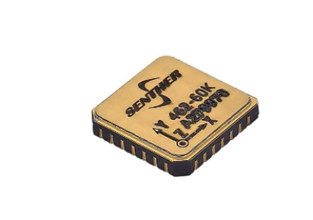In many fields such as industrial automation control, automotive, seismic measurement, military and space systems, precise measurement and control of instantaneous impact force or impact acceleration are often required, and impact acceleration sensors have emerged. It is like a sharp 'perceiver', able to quickly capture the acceleration changes of objects when they are impacted, and convert them into measurable electrical signals, providing key basis for subsequent data analysis and decision-making.
Senther MEMS piezoresistive type 462-60K

1、 Working principle cornerstone: Newton's second law
The working principle of an impact acceleration sensor is rooted in Newton's second law, which states that F=ma (force equals the product of mass and acceleration). When the sensor is impacted, the internal mass block will be subjected to force due to acceleration. By cleverly measuring this force, the acceleration generated by the impact can be calculated in reverse. On this basis, various types of impact acceleration sensors have been developed based on different conversion principles, each with its own unique characteristics.
(1) Piezoelectric impact acceleration sensor: instantaneous excitation of electrical energy
The piezoelectric impact acceleration sensor utilizes the magical positive piezoelectric effect of piezoelectric materials. When subjected to an impact force, piezoelectric materials undergo deformation, which in turn promotes the generation of charges on their surface, which accumulate to form a voltage signal output. Common piezoelectric materials include quartz crystals, piezoelectric ceramics, etc. They are like tiny "electricity generators" that can quickly convert mechanical energy into electrical energy when subjected to mechanical force impact. Due to its extremely fast response speed, it can capture impact signals in a very short period of time. Therefore, in situations where rapid response is required, such as measuring the impact at the moment of explosion or the impact force during bullet firing, piezoelectric impact acceleration sensors are highly effective.
(2) Capacitive impact acceleration sensor: subtle presentation of capacitance changes
The capacitive impact acceleration sensor converts signals by changing the capacitance of the capacitor. It usually contains movable mass blocks and fixed electrodes inside. When the impact force strikes, the mass block undergoes displacement, causing a change in the distance or relative area between the two plates of the capacitor. According to the calculation formula for capacitance, the capacitance changes accordingly. By detecting this capacitance change through precise measurement circuits, accurate impact force information can be obtained. Capacitive sensors have high accuracy and stability, and are relatively insensitive to environmental interference. They are widely used in applications that require high measurement accuracy, such as aircraft impact testing in the aerospace industry and drop impact detection in high-end electronic devices.
(3) Strain gauge impact acceleration sensor: precise measurement of resistance changes
The strain type impact acceleration sensor works by utilizing the strain effect of strain gauges. Strain gauges are generally made of metal or semiconductor materials and have the characteristic that their resistance value changes with mechanical strain. When the sensor is impacted, the internal elastic element will deform, and the strain gauge attached to the elastic element will also undergo strain, resulting in a corresponding change in its resistance value. By connecting the strain gauge to the Wheatstone bridge circuit, the change in resistance value will cause a change in the output voltage of the bridge. By measuring this voltage change, the acceleration can be accurately calculated. Strain gauge impact acceleration sensors have the advantages of simple structure, low cost, and high measurement accuracy, and are widely used in equipment impact monitoring, automotive collision testing, and other aspects of general industrial production.
(4) Magnetic electric impact acceleration sensor: clever application of electromagnetic induction
The magneto electric impact acceleration sensor is based on the magneto electric effect, which means that when a conductor cuts magnetic lines in a magnetic field, it generates an induced electromotive force. It is mainly composed of magnets, coils, and movable components inside. When impacted, the movable component drives the coil to move in the magnetic field, thereby generating induced current or voltage signals in the coil. Magnetic electric sensors have a large output signal and strong anti-interference ability, making them suitable for situations where signal strength is high and environmental electromagnetic interference is significant, such as impact detection of large mechanical equipment and strong impact measurement in earthquake monitoring.



